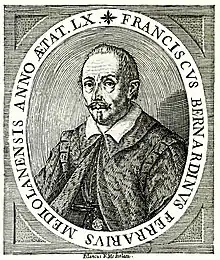Francesco Bernardino Ferrari
Francesco Bernardino Ferrari was an Italian archaeologist, one of the first and most distinguished scholars of the Collegio Ambrosiano founded by Cardinal Federico Borromeo.[1]

Biography
Born in Milan in 1576, he entered the Congregation of the Oblates of Saints Ambrose and Charles. He studied philosophy and divinity, as well as the Latin and Greek languages, and was admitted a doctor of the Ambrosian college. Federico Borromeo, archbishop of Milan, appointed him to travel into various parts of Europe to purchase the best books and manuscripts to form a library at Milan. Ferrari passed over part of Italy and Spain, and collected a great number of books, which laid the foundation of the famous Ambrosian Library. About 1638 he was appointed director of the College of the Nobles, lately erected at Padua, which office he discharged two years, and then, on account of indisposition, returned to Milan. He died in Milan on February 3, 1669.
Works
- De Antiquo Eccles. Epistolarum Genere libri tres (Milan, 1613);
- De Ritu Sacrarum Ecclesiae Catholicae concionum libri tres (Milan, 1620; Utrecht, 1692, cum praefatione Joannis Georgii Graevii);
- De Veterum acclamationibus et plausu libri septem (Milan, 1627; also in vol. VI of Graevius's Thesaur. Antiq. Rom.).
His writings are full of learning; he is very judicious in his conjectures, and exact in his quotations.
Notes
- Knox, Dilwyn, Ideas on Gesture and Universal Languages, c. 1550-1650. In John Henry; Sarah Hutton, New Perspectives on Renaissance Thought, Duckworth, London, 1990, p. 111.
References
 This article incorporates public domain material from McClintock, John; Strong, James (1867–1887). Cyclopædia of Biblical, Theological and Ecclesiastical Literature. Harper and Brothers.
This article incorporates public domain material from McClintock, John; Strong, James (1867–1887). Cyclopædia of Biblical, Theological and Ecclesiastical Literature. Harper and Brothers.- Louis Ellies Dupin, Bibl. des Auteurs Eccles. 17:109 (Amst. 1711).